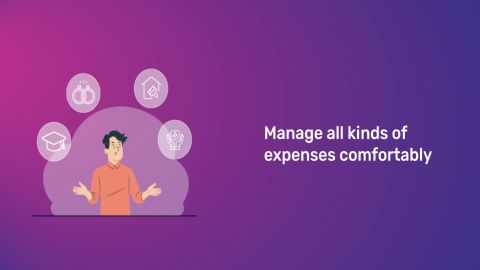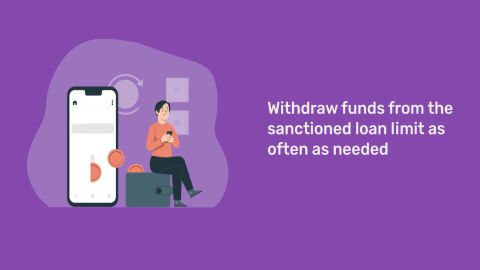Debt is a financial tool that touches nearly everyone's lives, offering access to resources that may not be immediately available. Whether it's borrowing from friends, obtaining personal loans, or using credit cards, debt can shape our financial journeys. In this article, we'll explore the fundamentals of debt, its various forms, and strategies for managing it effectively. Additionally, we'll introduce Bajaj Finance Limited as a reliable partner offering personal loans to help individuals navigate any tricky financial situations.
What is debt
In simple terms, debt refers to money borrowed by one party from another with the promise of repayment, usually with interest. It’s essentially an obligation to repay borrowed funds over time.
How debt works
Debt is a financial arrangement where one party borrows money from another with an agreement to repay it, typically with interest, over a specified period. When you take out a loan, whether it's for a personal, home, or car loan, you're committing to repay the borrowed amount plus any interest charged by the lender. The terms of the loan, such as the interest rate, repayment schedule, and duration, are typically outlined in a contract.
The interest rate determines how much extra you'll pay on top of the principal loan amount. The rate can vary depending on factors such as your creditworthiness, the loan type, and prevailing market conditions. Debt can be either secured, where assets like property are pledged as collateral, or unsecured, where no collateral is required. Responsible debt management involves making regular payments and avoiding accumulating too much debt relative to your income.
Types of debt
- Secured debt
Secured debt is backed by collateral, such as a home or a car. If the borrower fails to repay the loan, the lender can seize the collateral to recover their losses. - Unsecured debt
Unlike secured debt, unsecured debt isn’t backed by collateral. Credit cards and personal loans are common examples of unsecured debt. Lenders rely on the borrower’s creditworthiness to determine eligibility and interest rates. - Revolving debt
Revolving debt allows borrowers to repeatedly borrow and repay funds up to a certain credit limit. Credit cards are a prime example of revolving debt, where users can borrow up to their credit limit and repay it as they use it. - Instalment debt
Instalment debt involves borrowing a fixed amount of money and repaying it in equal instalments over a predetermined period. Mortgages and car loans are typical examples of instalment debt.
Addition Read: Difference Between Secured Debt and Unsecured Debt
Common forms of debt
- Mortgage debt
A mortgage is a loan used to purchase a home. The property serves as collateral, and the borrower makes monthly payments over the loan term, typically spanning several decades. - Personal loan debt
Personal loans provide a lump sum of money for various purposes, such as debt consolidation, home improvements, or unexpected expenses. These loans typically have fixed interest rates and repayment terms. - Student loan debt
Student loans are used to finance higher education expenses. They come with various repayment plans and interest rates, often subsidised by the government. - Credit card debt
Credit card debt occurs when cardholders carry a balance on their cards beyond the grace period. High-interest rates can quickly accumulate, making it challenging to pay off. - Auto loan debt
Auto loans are used to purchase vehicles. Similar to mortgages, the vehicle acts as collateral, and borrowers make monthly payments until the loan is repaid. - Business debt
Business debt encompasses loans and credit lines used to fund business operations, purchase inventory, or expand operations. Business owners are personally liable for some types of business debt.
An example of debt
A common debt example in finance is taking out a personal loan for a home renovation. For instance, imagine you borrow Rs. 3,00,000 from a bank at an interest rate of 12% per annum, with a repayment period of 3 years. This means you need to repay the borrowed amount of Rs. 3,00,000 plus the interest over the loan's tenure.
Each month, you'll make fixed EMI (Equated Monthly Instalment) payments, which will include both the principal loan amount and the interest. Over the three years, the total repayment amount will exceed Rs. 3,00,000 due to the interest charged, making this a clear example of debt in finance. By adhering to the repayment schedule, you can gradually reduce the debt and ultimately clear it by the end of the loan term.
Good debt vs. bad debt: What’s the difference?
The distinction between good and bad debt lies in how the borrowed funds are used and the potential for long-term benefits. Good debt is typically used to finance investments that will appreciate over time or generate income, such as taking out a loan for higher education or purchasing real estate. These types of debt often have lower interest rates and contribute to building wealth in the future.
On the other hand, bad debt is associated with borrowing for items that depreciate or provide no lasting value, such as using a credit card for unnecessary consumer goods or taking out high-interest loans for lifestyle expenses. Bad debt often leads to financial strain due to high-interest rates and can hinder wealth-building efforts. Understanding this difference is crucial in managing your financial health effectively.
Advantages and disadvantages of debt
Debt can offer financial flexibility but also comes with potential risks. Understanding both its advantages and disadvantages is crucial before taking on any borrowing.
Advantages of debt
- Access to immediate funds: Debt provides quick access to funds for urgent needs like home renovation, education, or medical expenses.
- Helps build credit history: Responsible debt management can improve your credit score, making future borrowing easier and cheaper.
- Tax benefits: In certain cases, interest paid on loans like home loans may be tax-deductible, reducing your taxable income.
Disadvantages of debt
- Interest payments: Over time, interest can significantly increase the total amount paid back, making loans more expensive.
- Risk of default: Failing to repay debt on time can lead to penalties, increased interest, and potential damage to your credit score.
- Financial strain: High debt levels can strain your finances, making it difficult to meet monthly expenses or save for future goals.
How to pay off debt
Paying off debt requires careful planning and discipline. The first step is to create a budget that accounts for all your income and expenses, leaving room for debt repayment. Once you've identified how much you can allocate towards paying off your debt each month, consider using strategies like the debt snowball method, where you pay off the smallest debt first, or the debt avalanche method, where you tackle high-interest debts first. Another helpful approach is consolidating multiple debts into a single loan with a lower interest rate, making debt payment more manageable. Regular, on-time payments can gradually reduce your debt in finance, ultimately leading to financial freedom.
Conclusion
Debt management is a crucial aspect of financial well-being, and Bajaj Finance Limited is committed to empowering individuals to navigate their debt responsibly. Whether through secured or unsecured personal loans, Bajaj Finance Limited offers transparent, flexible, and accessible financing solutions tailored to borrowers' needs.




